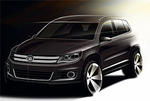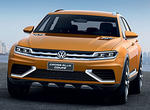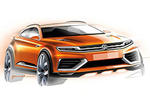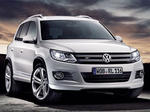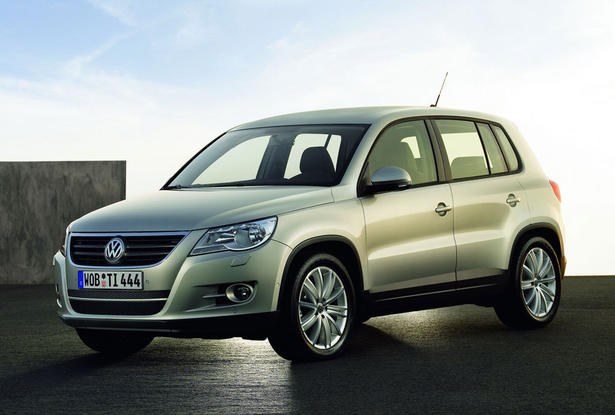
The Volkswagen Tiguan has its world premiere at the IAA in Frankfurt. All five engines of the Volkswagen Tiguan, for the first time on the SUV market, are charged delivering powerful propulsion just above the idling speed. The Volkswagen Tiguan satisfies the EURO-5 emissions standard, which does not go into effect until 2009. The Volkswagen Tiguan is equipped with Park Assist and the RNS 510 radio navigation system.
Volkswagen Press release:
The New Tiguan
Tiguan sets new standards with its high level of driving dynamics
- Driving-active Volkswagen Tiguan redefines interface between SUV and car
- First Volkswagen with fully charged engines without exception
- New and quiet common rail TDIs already fulfill Euro-5 emissions standard
- Maximum trailer load of 2,500 kilograms marks best value in its segment
Wolfsburg, September 2007. Volkswagen is showing the new Volkswagen Tiguan in a world premiere at the International Motor Show (IAA) in Frankfurt. This “small brother” of the Touareg
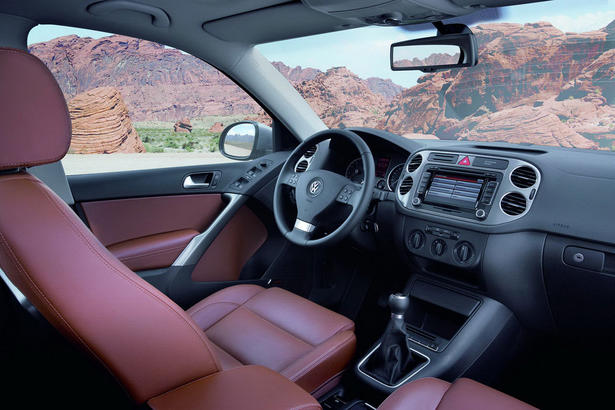
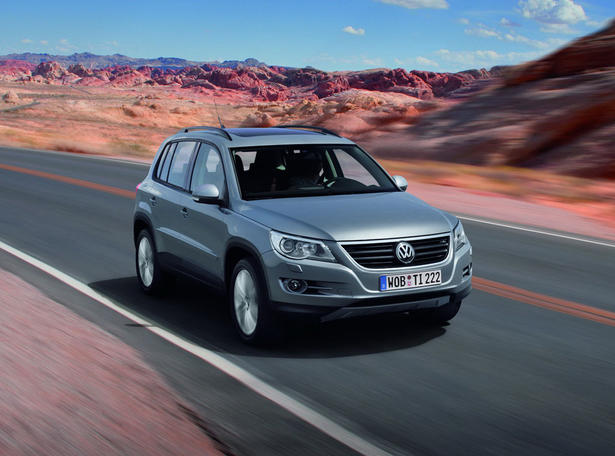
can be recommended to all those car drivers who enjoy the individual visual appearance and versatility of a SUV, but also expect a premium level of comfort, agility and variability. Its chassis sets new standards in the world of SUVs, because i t is extremely driving-active and safe. All five engines – for the first time on the global SUV market all engines are charged without exception – already deliver, powerful propulsion just above the idling speed. Today, the completely new and very quiet common rail TDIs already satisfy the Euro-5 standard that does not go into effect until 2009. Upon request, the Volkswagen Tiguan can be parked nearly
automatically in the urban jungle by the Park Assist feature. Off-road, on the other hand, the latest radio-navigation system (RNS 510) navigates its occupants back to civilization using its off-road function. Meanwhile, with up to 1,510 liters of cargo space, the Volkswagen Tiguan exhibits van qualities. 2,500 kilograms of trailer load also define the absolute best value in the Volkswagen Tiguan segment.
Trend&Fun and Sport&Style as clever and agile all-round talents
Very intentionally, Volkswagen Tiguan – offered in the equipment versions Trend&Fun, Sport&Style and Track&Field – is being offered in two body variants: The Trend&Fun and Sport&Style versions were specifically designed for primarily on-road use. Their agile, safe and highly comfortable driving behaviors are equal to those of a car. At the same time, these Volkswagen Tiguans do not shy away from either off-road drives or trailer loads. They leave the really rock-tough off-road routes to the Volkswagen Tiguan Track&Field.
Track&Field for more serious off-road duty
The Volkswagen Tiguan Track&Field was specially designed for life off of the asphalted
trails. Different than the Trend&Fun and Sport&Style versions, this especially adventure-friendly Volkswagen Tiguan exhibits a more extreme entry angle (28 instead of 18 degrees; maximum angle without the vehicle impacting the trail in front). As standard equipment the Volkswagen Tiguan Track&Field also has a newly developed off-road mode that awakens an entire armada of assistance systems to make drives off-road especially safe.
First SUV in the world exclusively with charged engines
As already outlines, the Volkswagen Tiguan is the first SUV in the world to be offered exclusively with charged engines. The advantage of engine charging: More power, less fuel consumption and lower emissions. Take the example of the gasoline engines: There will be three new TSIs – direct injection engines with turbocharging or turbocharging plus supercharging. The four cylinders deliver 110 kW / 150 PS, 125 kW / 170 PS and 147 kW / 200 PS. Take the example of the diesel: A completely redeveloped generation of noticeably quieter common rail four cylinder engines is being employed here. The two TDIs output 103 kW / 140 PS and 125 kW / 170 PS and smash the Euro-5 emissions standard.
Full-time 4MOTION all-wheel drive and two six-speed gearboxes
Full-time all-wheel drive is absolutely essential off-road. On paved streets an intelligent all-wheel drive also improves active safety. In the Volkswagen Tiguan the latest generation of 4MOTION all-wheel drive is used. It is shifted by manual, or optionally automatic, six-speed transmissions. Both transmissions satisfy special off-road requirements. The manual transmission can be driven at an engine speed of 1,000 rpm or vehicle speed of just 6.69 km/h, for example; this practically equals the crawler gear of a reduction gearbox. The automatic transmission has gear level preselect; in off-road use it prevents shifting to the next higher gear.
A SUV interior with the variability of a van
The Volkswagen Tiguan is an all-round talent. This characterization not only describes its powertrain properties, but also the multivariable and very spacious interior. The rear bench seat is split with a 60:40 ratio, it can be adjusted 16 centimeters in the longitudinal direction, and the rear seatback has multiple tilt adjustment settings. This provides either more legroom in the rear or additional space in the cargo area. Available as an option is a double cargo f loor including cargo management system. Also standard on the Volkswagen Tiguan Track&Field and Sport&Style is a folding front passenger seat so that very long objects can be stowed. With regard to the seat position, the passengers travel exceptionally comfortably, not only in front but also in the rear. The reason: Similar to the case in a movie theater, rear passenger seating is a bit higher and therefore more relaxed.
The Tiguan parks independently and finds the way back from the desert all by itself
On board an SUV for the first time is the Park Assist feature, with which the Volkswagen Tiguan turns into a parking space nearly automatically and impressively. The off-road mode already mentioned is a technology show; no other SUV in the world can call upon such a network of safety systems off-road at the press of a button. The Volkswagen Tiguan also exhibits its mastery when it comes to trailer load: It may range up to 2,500 kilograms, which is handled by the new, swiveling trailer hitch. In a class by themselves are the touchscreen radio and navigation systems; the top model (RNS 510) offers a standard 30 gigabyte hard disk memory, an off-road navigation mode and rearview camera. Any of the passengers can also look through a panorama sunroof at the sky of the savannah or the city.
The New Tiguan Design & Dimensions
Strong statement on 4.43 meters of length
- Powerful contours lend the Tiguan an athletic overall character
- Volkswagen Tiguan design transfers the mastery of the Touareg to another class
Wolfsburg, September 2007. The new Volkswagen Tiguan has a high-end, mature and astute image. It transfers the Touareg idea of the sovereign cruising and off-road SUV to another class. Just like his larger brother, the more compact Volkswagen Tiguan also masters the ride through both worlds – taking on asphalt as well as natural trails. The design of the Volkswagen Tiguan matches this character precisely.
Front end.
A typical, trusted, friendly Volkswagen. And yet everything is new, everything different. The radiator grille was further developed and its design was significantly reduced compared to before. The headlights are distinctive; they form an integral unit with the grille and bumper.
The engine hood is cut into the contour of the headlamps and lends a very concentrated look to the car’s face. Shaped to be broad and powerful is the bumper beneath the headlamps, and on the sides the fog lamps complete the image in their own frames.
The actual character of the front end, however, is generated by the interplay of all design characteristics. And in the process the 1.81 meter wide and 1.67 meter tall (without roof railing) Volkswagen Tiguan exhibits a clarity of form and proportion that make the approx. 4.43 meter long SUV stand out distinctively from the crowd in the big city jungle. The front end of the Volkswagen Tiguan Track&Field – specially designed for uncompromising off-road duty – takes up a special position. With regard to achieving the greatest possible entry angle (28 instead of 18 degrees), it does not have the pronounced front spoiler with matching air inlets that is found on the Volkswagen Tiguan Trend&Fun and Sport&Style. Rather, here a distinctive integrated engine underbody protection plate extends diagonally from a line between the tires up to the radiator grille.
Side profile.
In its side profile clarity and power also dominate the forms; here too there are no details that appear random or not thought out to completion. Viewed from the side, except for the small VW symbol in the wheel rims, there is no logo that “gives away” the Volkswagen Tiguan as a Volkswagen. And yet, there is no doubt that it can be made out as a Volkswagen at first glance. Clarity and power form very unique wheel arches, a window line that rises from front to back, the door and fender surfaces designed with strong modulation, as well as new, unmistakable C pillars.
Each detail follows a logic of form and unifies the whole. The Volkswagen Tiguan thereby exhibits the same visual presence as the Touareg.
Rear end.
Typical of Volkswagen is the design of the rear end. But here too it is both typical and yet entirely different. Typical, because the basic layout of the taillights follow the pattern of the Eos and the Passat Variant and are part of the powerful shoulder section. It is different, because the overall design takes new paths, the steep tailgate extends far into the bumper and is part of a design and the classic, pure SUV elements are combined with contemporary, urban forms. The lowermost segment of the bumper is similar to the front end is not painted with a view toward impact resistance for off-road duty.
The New Tiguan Body
One car, two front ends, highest quality standards
- High torsional rigidity for the best comfort and ideal crash properties
- Newly designed trailer hitch swivels out of the bumper with lightning speed
Wolfsburg, September 2007. For the first time in the SUV segment buyers of the new Volkswagen Tiguan can choose from two different front ends. The equipment versions Trend&Fun and Sport&Style were designed specifically for mostly on-road duty. It ref lects precisely this goal in its classic front end with maximum entry angle of 18 degrees.
They leave tough off-road duty to the Volkswagen Tiguan Track&Field. It was designed especially for life outside of the paved trails. Different than its counterparts for the “urban jungle” this particularly adventure-friendly version exhibits a more extreme entry angle of 28 degrees in front. The lower bumper area and engine underbody protection therefore exhibit a very steep angular profile. This is precisely why the vehicle can climb a ramp or level embankment up to the specified 28 degrees without the front end of the Volkswagen Tiguan contacting this ramp when approaching from the horizontal.
Identical on all models: The rear departure angle of 25 degrees and the so-called ramp angle between the two axles of 20 degrees. Ground clearance is a uniform 195 millimeters here.
Torsional rigidity.
In the structural layout of the body the primary focus was on two aspects: Optimal comfort and the best crash properties. The fact is: The characteristic values of 45 Hertz each for static and dynamic torsional rigidity influence parameters such as driving dynamics, vibration behavior and acoustics in an extremely
positive way. Even in tough off-road duty no torsional twisting whatsoever is detectable on the body.
Roof carrier and trailer load.
Both the Volkswagen Tiguan Sport&Style and the Volkswagen Tiguan Track&Field equipment lines offer standard roof rails; it can be loaded with up to 100 kilograms payload. Far greater transportation tasks can be mastered with the swiveling trailer towing unit. If necessary, the Volkswagen Tiguan can pull a maximum of 2,500 kilograms (braked trailer at 12 percent incline) from its hitch, putting it in sole position at the top of its vehicle segment.
Trailer hitch.
The trailer hitch itself is manually swiveled out or folded back in just seconds by cable pulley technology. This eliminates complicated and time-consuming assembly of the trailer hitch with slot engagement and locking. Dirty hands are also passé, since the cable pulley with ergonomic knob is located at the upper left, housed directly on the bumper under a separate cover.
When the tailgate is closed this protects the unit from dirt and makes it inaccessible to unauthorized persons. The mechanism operates so smoothly that just a small push with the foot is sufficient to securely lock the system in place. An LED lights green in the actuating knob as soon as the hitch is securely locked in place and ready for operation.
The New Tiguan Interior
Multivariable interior with up to 1,510 liter cargo volume
- Rear bench seat movable in longitudinal direction; front passenger seat folds
- 650 kilograms payload capacity guarantees the greatest transport flexibility
Wolfsburg, September 2007. Volkswagen gave attention right to the last detail in the new Volkswagen Tiguan, and gave it a decidedly ergonomic and very spacious interior along the way. At all five seating positions on board the Volkswagen Tiguan occupants are equally comfortable. The rear bench can be adjusted in the longitudinal direction and has an asymmetrically split folding sections. In this case, objects up to 2.5 meters in length of any type disappear inside the Volkswagen Tiguan; it is transformed into an all-wheel drive van.
Cockpit and instrument panel.
The instruments with their high-end visual and tactile quality are clearly arranged. All controls are located where one would intuitively expect to see them. Take the example of the center console: Integrated at the top, within the optimal viewing field of driver and front passenger, is the new generation of radio and navigation system. Main functions are controlled by keys and knobs, while sub-functions are controlled via a touchscreen. Just to the right and left of the audio system are two air vents each. The entire unit is encased by a high quality frame that has a stainless steel appearance.
Located at the next level down is the standard semi-automatic climate control system known as “Climatic”. Ergonomically designed switches for window lifts and mirror adjustment are also easy to reach in the upper area of the driver’s door.
Front seats.
The seating system in the Volkswagen Tiguan is available in three configurations, depending on the equipment line. The Volkswagen Tiguan Trend&Fun will be delivered with so-called “normal seats” that already offer good comfort on long trips and height adjustment on the driver’s side. Positioned above this is the Sport&Style equipment line. Here the seats are – true to the line’s name – “Sport seats” with integrated adjustable lumbar support. Meanwhile, the Volkswagen Tiguan Track&Field is equipped with “Comfort seats”, each with adjustable lumbar support.
Rear seats.
The three-part rear seating system is a bench split in a 60:40 ratio; in addition the center section of the seatback can be folded down to be used as a center arm rest, drink holder or cargo pass-through. The individual seat elements can also be adjusted by 16 centimeters in the longitudinal direction. Independent of this adjustment, the rear seatbacks can be adjusted over a reclining range of 23 degrees.
Cargo area.
Neat, variable, functional and level – these are key words that accurately describe the cargo area of the Volkswagen Tiguan. With five persons on board it already stows 470 liters. Up to 1,510 liters and 650 kilograms payload can be stowed in the Volkswagen Tiguan when the rear seats are folded down. This moves it right next to genuine mid-class station wagons. So-called gap f laps close the gaps that occur when the seat unit is folded away, thereby forming a level cargo f loor. Chrome-plated tie-down eyes, shopping bag hooks, a 12-Volt accessory plug and other functional elements make this a truly multivariable cargo area. A net partition also provides for safety when loaded to ceiling height.
The New Tiguan Engines and Transmissions
First SUV in the world exclusively with charged engines
- New Common Rail TDIs already satisfy Euro 5 emission standard today
- High torque TSIs are predestined for off-road use
Wolfsburg, September 2007. The Volkswagen Tiguan will be the first SUV in the world to arrive on the market exclusively with charged TDI and TSI engines. The advantage: Greater power and torque, better fuel economy and lower emissions. In the starting phase, the new SUV will debut with a new 110 kW / 150 PS strong TSI and the first four cylinder commmon rail TDI of the Volkswagen brand; it outputs 103 kW / 140 PS.
Over the mid-term two other TSIs and a TDI will be offered. They are all new to the Volkswagen lineup. The TSI range will be extended by adding two four cylinder engines: 125 kW / 170 PS and 147 kW / 200 PS. Following up in the diesel area, there will be a powerful 125 kW / 170 PS TDI; it also sports newly develope common rail injection. The stated development goal here was to offer the quietest diesel engines of the class in the Volkswagen Tiguan. Both direct-injection turbo-diesel engines will already fulfill the Euro-5 that does not go into effect until 2009. The engines of the Volkswagen Tiguan in detail:
TSI with 110 kW / 150 PS.
The new 110 kW TSI (with supercharger and turbocharger) accelerates the Volkswagen Tiguan to 100 km/h in 9.3 seconds. Its top speed is a respectable 192 km/h. Maximum engine torque: 240 Newton-meter, available from a low 1,750 rpm. Fuel consumption: 8.4 liters per 100 kilometers. Special feature: In combination with the Volkswagen Tiguan Track&Field, the supercharger on this TSI is always engaged in off-road mode, in order to be able to master even the most difficult off-road passages with high torque at low rpms and vehicle speeds.
TSI with 125 kW / 170 PS.
In the mid-performance position, a newly developed TSI engine is being introduced with 125 kW / 170 PS. The two-liter directinjection turbocharged engine accelerates the Volkswagen Tiguan to 100 km/h in just 8.2 seconds. Its top speed is 200 km/h, and maximum torque is 280 Newton-meter (at 1,800 rpm). On average, the Volkswagen Tiguan TSI with 125 kW consumes 9.1 liters of fuel per 100 kilometers.
TSI with 147 kW / 200 PS.
For the time being, the strongest engine on the new Volkswagen Tiguan will be the 147 kW / 200 PS version of the 2.0 TSI. Although its performance data match those of the engine used in cars like the Golf GTI, the
engine used here represents a new engine generation. In this case, the maximum torque of 280 Newton-meter that is already available at 1,700 rpm remains constant up to 5,000 rpm. After just 7.6 seconds the most powerful Volkswagen Tiguan is moving at 100 km/h; and the forward propulsion does not end until 211 km/h.
Average fuel consumption is identical to that of the 170 PS version at 9.1 liters of super unleaded.
TDI with 103 kW / 140 PS.
Both TDI engines of the Volkswagen Tiguan are completely new developments. On the light 166 kilogram common rail TDI, injection pressures up to 1,800 bar produce especially fine atomization of the fuel. Eight-hole injection nozzles drive the state-of-the-art piezo injectors. The result in the case of the 103 kW TDI: 320 Newton-meter maximum torque at a low 1,750 rpm. Only 10.4 seconds elapse during the acceleration to 100 km/h. This Volkswagen Tiguan TDI reaches a top speed of 186 km/h. Its fuel consumption is 7.2 liters of diesel
per 100 kilometers.
TDI with 125 kW / 170 PS.
The more powerful of the two new TDIs with common rail injection outputs 125 kW / 170 PS. Its maximum torque is a considerable 350 Newton-meter (at 1,750 rpm). After just 8.9 seconds this Volkswagen Tiguan is already 100 km/h fast. Its peak speed is 200 km/h. This contrasts with an average consumption of 7.0 liters per 100 kilometers.
Six-speed manual and automatic transmissions.
All Volkswagen Tiguans are delivered with six-speed transmissions as standard equipment. As an option, the two strongest gasoline engines (170 PS and 200 PS) as well as the 140 PS TDI may be ordered with a six-speed automatic. Both transmissions fulfill special off-road requirements. The manual transmission can be driven at an engine speed of 1,000 rpm or vehicle speed of just 6.69 km/h, for example; this practically equals the crawler gear of a reduction gearbox. The automatic transmission has gear level preselect; in off-road use it prevents shifting to the next higher gear.
The New Tiguan 4MOTION
Haldex clutch controls power distribution in seconds speed
- 4MOTION provides more grip off-road and more safety on-road
- Latest generation of the 4MOTION all-wheel drive debuts in the Volkswagen Tiguan
Wolfsburg, September 2007. In 1998 Volkswagen presented the highly advanced 4MOTION system as the successor to the fulltime “syncro” all-wheel drive. Over nearly a full decade, the all-wheel drive concept has been continuously further developed in various technical configurations. An important design property of the 4MOTION systems installed in car segments up to the Passat V6 FSI (another technology is used on the Phaeton and Volkswagen Tiguan) is the very quick reacting Haldex clutch. The latest version of this technology operates on the Volkswagen Tiguan.
The defined development goal was an all-wheel drive that satisfies the highest standards for driving dynamics and driving safety on the road, while simultaneously offering optimal traction off of the paved trails. In practice, this means: Hardly any perceptible additional fuel consumption, no effects on the engine and no running noises.
4MOTION details.
The electro-hydraulic Haldex clutch runs in an oil bath. The multi-plate clutch system itself was integrated in the rear axle drive of the Volkswagen Tiguan; the entire unit weighs just 44 kilograms. As soon as speed differences develop between the front and rear axles, two annular piston pumps are activated that build up pressure in the multi-plate clutch and join the axles to one another. The transferable torque varies with the magnitude of the pressure applied to the clutch plates, and this controls the flow of force between the front and rear wheels according to specific needs and stepless. As soon as the clutch detects slip at the front axle, more engine torque is applied to the rear axle. Normally, 90 percent of the propulsive force is to the front wheels and ten percent to the rear. In extreme cases, however, nearly 100 percent can be transferred to the rear axle.
The New Tiguan Chassis
Agility and active safety like in a passenger car
- Front axle: McPherson system with aluminum subframe
- Rear axle: Innovative four-link axle complements all-wheel drive ideally
Wolfsburg, September 2007. Right from the beginning it was clear: The new Volkswagen Tiguan should be a leader in its class when it comes to dynamics, comfort and safety. Consequently, in the context of chassis development the top priorities were agile handling properties, a high level of vibration and rolling comfort, low roll angle with harmonious roll dynamics, very good driving stability and yet optimal off-road driving ability. The development team pulled out all stops to attain these objectives. The results: Neutral to slightly understeering handling and exceptionally low roll angle. This goal was achieved with a chassis layout that actually sets new standards with regard to driving dynamics, active safety and convenience. Next year an electronic suspension control system will be added. Tuning will then vary situationdependently between the levels “Comfort“, “Normal” and “Sport”. Details of the chassis:
Front axle.
Used in front of the Volkswagen Tiguan is a McPherson suspension specially tuned for the SUV with lower wishbones and wheel-locating struts. It is mounted on a one-piece aluminum subframe.
Rear axle.
The four-link rear suspension was tuned for the full-time 4MOTION all-wheel drive. The very robust but at the same time dynamically laid out axle geometry has already been proven out in similar form on the Passat 4MOTION. With regard to tough off-road duty, the Volkswagen Tiguan utilizes a frame made of high-strength steels. For the rear suspension newly developed shock absorbers were also developed with increased oil volume; the favorable temperature level makes the shock absorbers fit for even the toughest off-road drives. Like the suspension struts of the front suspension that were also redeveloped, both components offer exceptionally good comfort properties.
Steering.
One technological highlight indirectly related to the chassis is the completely redeveloped next generation of electro-mechanical power steering. The decisive advantage of the system: Despit very precise steering feel, no kickback pulses whatsoever are transmitted to the steering unit, even in off-road operation. This is primarily due to a newly constructed steering gear.
Wheels and tires.
Handling the contact to the road or trail in the Trend&Fun and Track&Field versions of the Volkswagen Tiguan are 16-inch wheels with size 215/65 R16 tires. The Volkswagen Tiguan “Sport&Style” gets standard 17-inch alloy wheels and size 235/55 R17 tires. 18-inch wheels with tires in 235/50 R18 format will be offered as a special option
The New Tiguan Standard & Special Equipment
Three equipment lines with high levels of convenience and safety
- Climatic, CD-Radio, ESP and electronic parking brake are standard
- Park Assist and Off-Road Switch simplify life in city and on the savannah
Wolfsburg, September 2007. The Volkswagen Tiguan is the first SUV in the compact class to have two front ends. These body versions are each combined with specific equipment lines. There are three of these lines. The front end of the Trend&Fun and Sport&Style lines was designed for a maximum entry angle of 18 degrees its service environment is essentially paved terrain. The front module of the Track&Field equipment line (28 degree entry angle), also a high-end line, was specially designed for tougher
off-road duty.
Trend&Fun.
Even the base version of the Volkswagen Tiguan has extensive convenience and safety features. When it comes to safety, these include a protective network of six airbags, the ESP electronic stabilizatin program, trailer stabilization integrated in ESP (for vehicles with trailer hitch), Isofix child seat anchorages on the rear bench and electronic parking brake with Auto-Hold function. Standard on-board convenience features also include the RCD 210 radio with integrated CD player, “Climatic” semi-automatic climate control system, four electric window lifts, electrically adjustable and heated outside mirrors, Multifunctional Display Plus (trip computer), RF remote control of central locking and various storage compartments and bins.
Sport&Style.
Some of the features of the very exclusive Volkswagen Tiguan Sport&Style, in addition to those of the Volkswagen Tiguan Trend&Fun, are: 17-inch “Los Angeles” alloy wheels with size 235/55R17 tires, chrome roof rails, protective radiator screen with chrome accent strips and window graphics in chrome, tinted windows starting at the B-pillars (up to 65 percent light absorbing), sport seats with height-adjustable lumbar supports, center console with folding and height-adjustable armrest, folding front passenger seat, drawers under the front seats, folding table and storage pockets on the backs of the front seats, leather for steering wheel, gear shift knob and gear shift boot, fabric seats with Alcantara accents, cruise control system and tire pressure indicator.
Track&Field.
The Volkswagen Tiguan Track&Field was specially configured for tough off-road duty with its 28 degree front module. Standard equipment on the Volkswagen Tiguan Track&Field includes an off-road switch, which at the press of a button awakens an entire armada of assistance systems for making drives off-road especially safe. Specifically, in one fell swoop this switch activates the hill descent assistant (optimal control in descents), modified driving pedal characteristic (finer metering of engine torque), EDS adaptation (electronic differential locks are activated at the slightest slip), ABS adaptation (improved braking on loose substrates), hill ascent assistance (support in ascents and clutch protection) and – together with an automatic transmission – gear level preselect (including optimal engine braking effect).
Moreover, at no additional cost Volkswagen sends the Volkswagen Tiguan Track&Field out for adventures, large or small, with the 16-inch “San Diego” alloy wheels, tire pressure indicator, black roof rails, engine underbody protection, compass display and special door impact guard strips. The Volkswagen Tiguan Track&Field is also equipped with “Comfort seats” that have adjustable lumbar supports.
Special equipment options.
Typical of Volkswagen is the standard practice of designing the functionality of components at the interfaces to the driver to be as comfortable as possible. That applies precisely to every new technology that is implemented in a new Volkswagen. And there are many of these in the new Volkswagen Tiguan:
Park Assist.
The numerous high-end technologies of the Volkswagen Tiguan include the first Park Steering Assistant implemented in a SUV in the world. The so-called Park Assist function enables automatic backing into a parking space parallel to the roadway. The driver just actuates the gas pedal, brake and clutch; the Volkswagen Tiguan meanwhile steers into the pre-measured space under sensor control. As soon as the driver manually intervenes in the steering process, the Park Assist function is deactivated.
Radio and navigation systems.
The Volkswagen Tiguan is being offered with a completely new radio and navigation systems. The RCD 510 radio (including 6-disk CD changer, optionally with DAB digital radio reception) and RNS510 radio-navigation system are controlled in part via a touchscreen (6.5 inch). Also part of the RNS 510 hardware is a Power-PC processor running at 400 MHz and a dedicated graphics processor. The navigation and entertainment data are saved on a 30 gigabyte hard drive. Another SD card slot (including for MP3 files) is located below the display on both devices.
Off-road navigation.
One innovation of the RNS 510 is its specially developed off-road navigation mode. In this mode, up to 500 waypoints can be stored while driving in non-digitalized areas. That is how drivers can find their way back from any off-road adventure. The tours can be automatically recorded by manually saving of waypoints or automatically (Track function).
Rearview camera.
Another standard component of the RNS 510 radio-navigation system is the rearview camera. It is located directly above the license plate, and it transmits a real-time distortion-free image to the display of the RNS 510. The route is also shown in the display, as on the Touareg, utilizing orientation lines corresponding to the specific steering wheel movement.
Trailer towing unit.
With a trailer load of up to 2,500 kilograms, the Volkswagen Tiguan sets a new best value in its segment. In addition, the trailer hitch is a new design concept. Utilizing cable pulley technology, the trailer hitch unit is swiveled out from under the bumper in just seconds, and it can be folded back just as quickly, conveniently and cleanly. There is no longer any complicated assembly with slot engagement and locking. As soon as the hitch is securely locked in place, an indicator lights green.
Panorama sunroof.
300 percent more. More light, more viewing, more sun. With its enormous Panorama Sunroof (PSD) the Volkswagen Tiguan offers 300 percent greater roof cutout area than a conventional Golf sunroof. Despite all of this, it was possible to achieve the rigidity values of the closed variant, which are especially important for an SUV.






